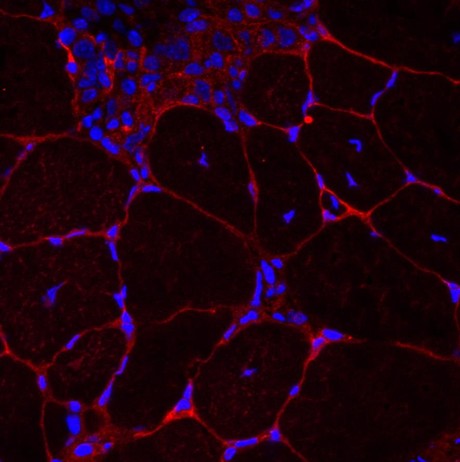3D scaffolds to grow muscle

Australian biomedical engineers have successfully produced a 3D material that mimics nature to transform cells into muscle. The development offers hope to people suffering from injuries where their muscles cannot repair themselves due to trauma or disease, and our rapidly ageing population.
Led by Dr Richard Williams from RMIT University, the researchers have combined lab-made peptides with natural proteins and polymers to create a 3D ‘hydrogel scaffold’. The scaffold uses natural mechanisms to incorporate signals found in the natural developmental environment to support and engineer stem cells into muscle fibre.
“Our stem cells are at their best during development, where a scaffold drives them to produce all our tissues and organs; yet as people grow and age, they lose this ability and get a build-up of undesirable structures,” Williams said.
“So there is a real need for ways to repair and replace parts of the body as they wear out or become damaged, particularly as our population is now living longer.
“Essentially, we make a scaffold that sends healthy signals to the cells to reorganise themselves to start to grow the small fibres that make up a healthy muscle.
“It’s like travelling back in time when our potential for tissue development and repair was at its best.”
Williams said it is a “simple process” to deliver complex structures inspired by the way nature pieces structures together during development, starting with only two cells.
“We have developed a simple, cheap, yet powerful toolkit that encourages different environments to let different tissues grow,” he said.
“The material properties of natural tissues, like muscles, are really complex and extremely difficult to mimic synthetically.
“Researchers have been producing ‘organising’ signals for years to understand how cells work but only in a flat, or 2D, environment.
“We have found a way to use the proteins present during embryonic development in a 3D scaffold, and use this extra dimension to potentially grow muscle.
“Our research shows that combining a hydrogel with these small proteins is easy and effective. In fact, just 24 to 72 hours after seeding the cells into the tissue, there was a noticeable reorganisation of individual cells into the multi-cellular structures that go on to make up functioning muscle.”
The RMIT researchers are now exploring how they can bioprint muscle with the stem cells already embedded to put nerves, blood vessels and muscles together into lab grown “spare parts”.
The research has been carried out at RMIT University in Melbourne, Australia, in collaboration with St Vincent’s Hospital Melbourne, Deakin University and the Australian National University. The scaffold has been developed in Melbourne’s BioFab3D@AMCD lab — Australia’s first robotics and biomedical engineering centre embedded within a hospital.
The researchers’ findings are published in Biomacromolecules.
Breakthrough blood test for endometriosis developed
Scientists identified 10 protein biomarkers, or 'fingerprints' in the blood, that can be...
A simple finger prick can be used to diagnose Alzheimer's
A new study is paving the way for a more accessible method of Alzheimer's testing, requiring...
Experimental blood test detects early-stage pancreatic cancer
The new test works by detecting two sugars — CA199.STRA and CA19-9 — that are...




